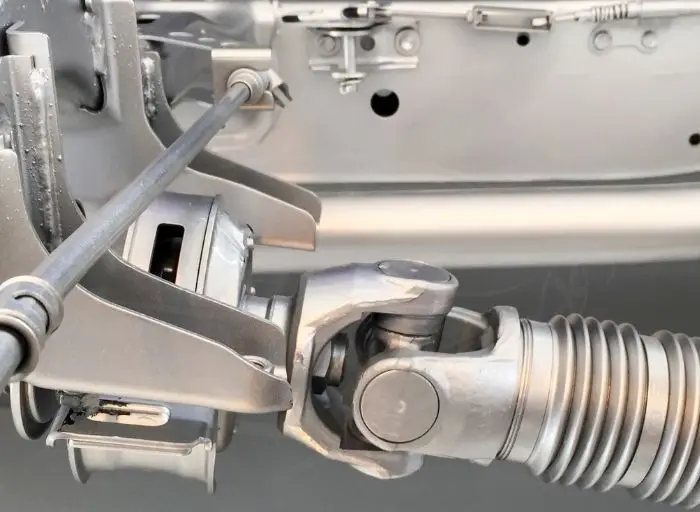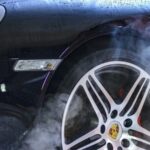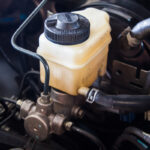
If you notice a driveshaft on your car is not spinning, it’s time to replace it. Wondering what causes a drive shaft to break? You’d better watch out for the failing drive shaft symptoms as it’s dangerous if it breaks while driving.
Table of Contents
What Is A Drive Shaft?
A drive shaft is a metal, circular piece of material that connects the transmission to the engine. It’s connected to the transmission through a universal joint, which allows drivers to shift gears while they are driving. The drive shafts connect the wheels to the axles, allowing them to rotate so you can move forward.
What Causes Drive Shaft to Break?
There are several factors that can lead to a broken drive shaft:
- Neglect of regular servicing: Over time, the drive shaft bearings will wear out, causing the driveshaft to give in after heavy use. That’s why you need to have it checked every now and then, especially if you have a heavy vehicle, so it can be replaced immediately if there’s a problem.

- Excessive weight: Apart from the problems naturally caused by time, a broken driveshaft is often caused by excessive weight from different components of the vehicle. Pay close attention to the engine, transmission, and rear differential, as they are usually extra heavy.
- Road hazards: The driveshaft is also susceptible to road hazards such as potholes or loose gravel. That’s why you shouldn’t drive your vehicle in really bad conditions. If you notice that there are some problems with your vehicle, then it’s time to replace the broken driveshaft.

- Overloading: The driveshaft is designed to handle a certain amount of weight. If you overload the vehicle or work with excess weight on it, then it can cause the driveshaft to break. Heavy equipment should be secured properly before use to avoid breaking the drive shaft.
- Damaged universal joints: The universal joints connect the driveshaft to the transmission and will wear out after constant use. Corrosion and faulty seals can also cause problems with the universal joints leading to a broken driveshaft.

- Incorrect repair work: The drive shaft should be handled by a professional when replacing worn-out parts such as the bearings, universal joints, and seals. When installed incorrectly, the new parts also could break the shaft.
- Poor quality drive shafts: aftermarket or fake parts aren’t high quality, so that the driveshafts may break before their normal life span.
Failing Drive Shaft Symptoms

A drive shaft won’t break suddenly; you’ll notice several unusual behaviors in the car:
- You’ll know that the driveshaft has broken if you notice that it’s no longer spinning or that it’s slipping when you try to shift gears.
- You’ll also see that the transmission is not shifting well, and there will be excessive noise from it.
- When you turn left, the car should move to the right and vice versa. But when you replace a broken drive shaft, your car should not fall in this way, so replace it immediately.
How Does a Drive Shaft Break?
There are many things that can cause a drive shaft to break, such as too much torque, bad alignment, metal fatigue, worn-out u-joints, and impact damage.
- The drive shaft could twist and break when the torque is higher than suggested. Misalignment can make wear and tear happen in different places, leading to cracks and breaks.
- Over time, the drive shaft can weaken and break due to metal fatigue.
- Worn-out u-joints can make the drive shaft shake and put extra stress on it, which can cause it to break.
- Lastly, damage from road debris or collisions can cause dents, bends, or even breakage in the worst cases.
It’s important to find and fix these problems right away to avoid drive shaft failure and keep driving safe.
Why Does My Drive Shaft Keeps Breaking?
If your drive shaft keeps breaking, there is usually an underlying problem that must be addressed. Common causes of recurring drive shaft failure include:
- Excessive torque: If your vehicle has been changed to improve its power, the additional torque might place the drive shaft under additional stress and cause it to break.
- Incorrect alignment: If the drive shaft is not aligned correctly, it can lead to cracks and fractures due to unequal wear and stress.
- Metal fatigue: Over time, metal fatigue can lead to the deterioration and eventual failure of the drive shaft. This is particularly true if the vehicle is driven under big loads or on uneven terrain.
- U-joints connect the drive shaft to the transmission and differential. U-joints are worn. If worn, they can produce vibration and place additional stress on the drive shaft, leading to its failure.
- If the drive shaft is damaged by road debris or crashes, it might sustain dents, kinks, and, in severe circumstances, breaking.
It is crucial to have a trained mechanic inspect your car to determine the reason for the drive shaft failure and make the required repairs to avoid it from recurring.
How Can I Prevent My Drive Shaft from Breaking?
The drive shaft is a crucial component of your car’s drivetrain that transfers power from the engine to the wheels. If it breaks, it can cause serious damage to your car and potentially be dangerous to drive. Here are some tips on how to prevent your driveshaft from breaking and what to do if it does break.
- Regular Maintenance: Regularly inspecting and maintaining your car’s drive shaft can help prevent it from breaking. This includes checking for any signs of wear or damage, such as cracks or bends, and replacing worn or damaged parts.
- Avoid Overloading: Overloading your car with heavy cargo can put extra stress on the drive shaft, causing it to break. Make sure you don’t exceed your car’s weight limit and distribute the weight evenly to avoid putting too much stress on one part of the drive shaft.
- Watch for Vibrations: If you notice unusual vibrations or shaking while driving, it could be a sign that your drive shaft is starting to wear down or is out of balance. Get it inspected by a mechanic to prevent further damage.
FAQs
How much does repairing a damaged drive shaft cost?
Drive shaft repair costs typically vary depending on what caused the problem and how quickly it can be fixed. Replacing a bad shaft would range from $500 to $1000. However, you can also anticipate that the parts will cost around half as much, and the labor will cost about $200.
What are the symptoms of a broken drive shaft?
Symptoms of a broken drive shaft include:
- Loud clunking or banging noises coming from underneath the car
- Vibrations or shaking when accelerating or driving at high speeds
- Difficulty turning the steering wheel or controlling the car
- A burning smell coming from the transmission or differential
How long can driveshafts last?
A driveshaft’s lifespan is variable but normally lasts roughly 75,000 miles. Remember that the amount you receive could vary greatly based on the car and wear and tear. Your driveshaft is more likely to sustain damage if you have adjusted its height, so you will need to repair it sooner. Make sure all of the u-joints are thoroughly lubricated as one suggestion to lengthen the life of your driveshaft.
How many drive shafts are there in a car?
There are often two driveshafts on an all-wheel drive or four-wheel drive vehicle. The driveshaft is identical to the one found on a rear-wheel drive vehicle, but there is also a separate front driveshaft that is joined to the front differential and transfer case by u-joints.
Do I need to replace both drive shafts at the same time?
When a CV joint or boot is broken on a car with many miles on it, it is often best to replace both shafts simultaneously. Because right turns are more frequent than left turns and are made at a greater angle, the right (passenger side) shaft frequently fails first.
How do I fix a broken drive shaft?
To fix a broken drive shaft, you will need to replace it with a new one. This is a complex and labor-intensive process that requires specialized tools and knowledge. It’s best to take your car to a mechanic to diagnose the problem and repair it.
—
Now that you know what causes a drive shaft to break, you can take precautions to ensure this doesn’t happen to your vehicle. Visit an auto repair shop for regular inspections of your vehicle. This way, they can detect problems in time and replace damaged or worn-out parts.
Further reading:
- Drive Shaft Free Body Diagram
- Universal joint – Wikipedia
- How to Replace Universal Joints (with Pictures)
Hi there! I’m Naomi O’Colman. I’ve got years of experience working at an auto repair shop here in Texas under my belt. On top of that, ever since I was a kid I’ve been passionate about the auto industry. Since I’ve joined the team at automotivegearz.com I’ve been enthusiastically sharing my passion and insights with my readers. I’m dedicated to delivering high quality content and helping you stay up to date with the latest automotive trends and products out there!







